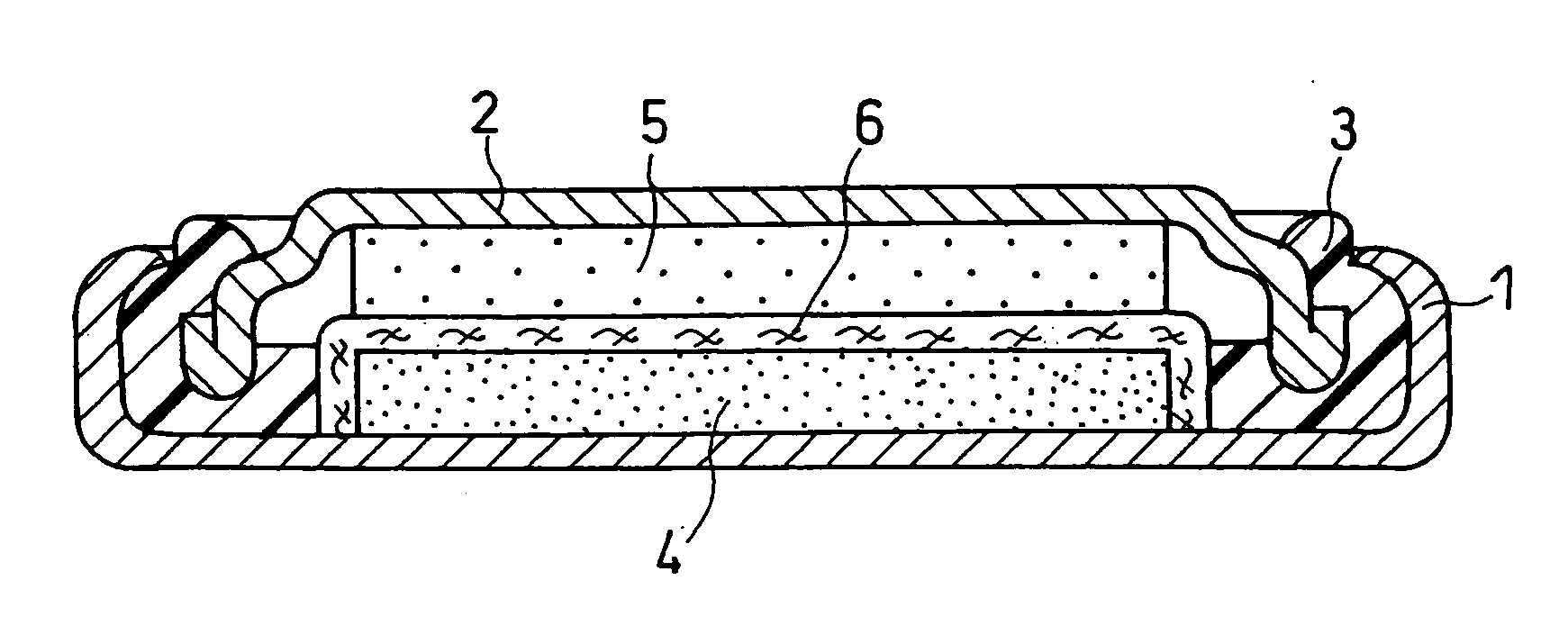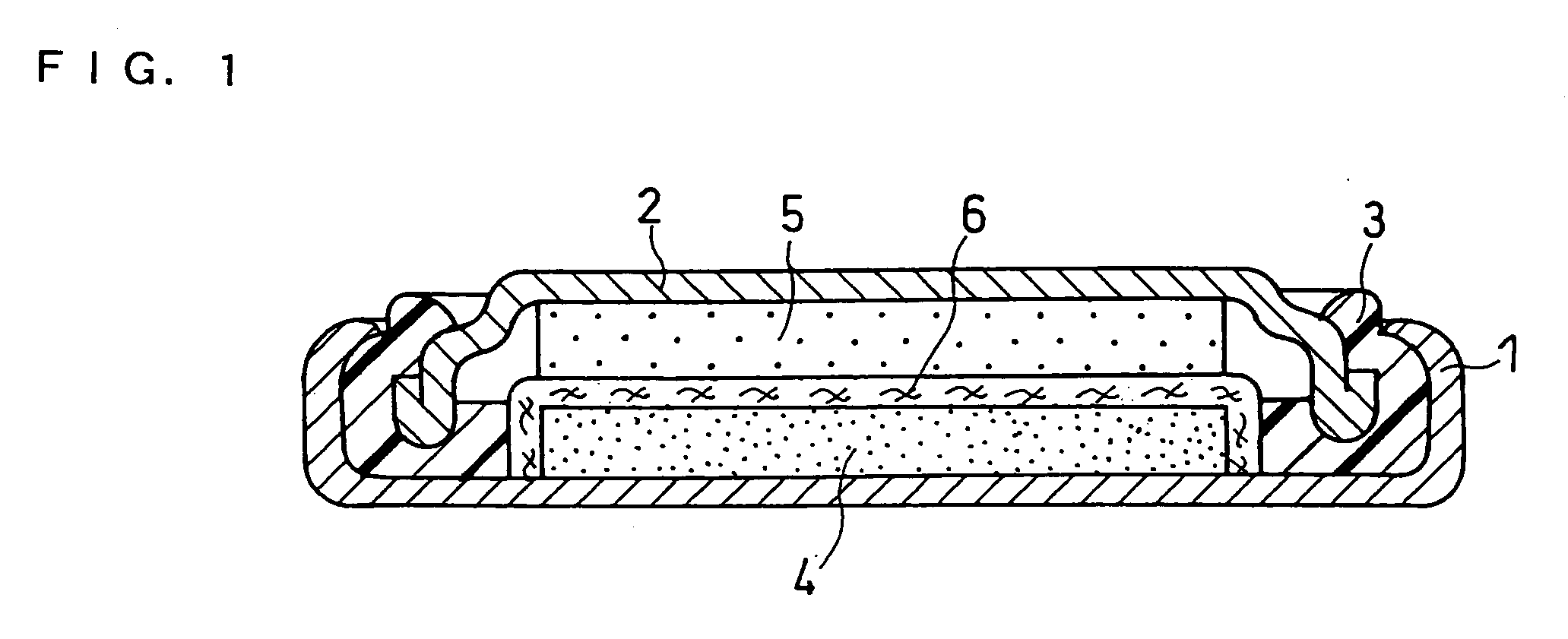Non-aqueous electrolyte secondary battery
a secondary battery, non-aqueous electrolyte technology, applied in the direction of active material electrodes, non-aqueous electrolyte accumulator electrodes, cell components, etc., can solve the problem of insufficient binding property, inability to prevent completely the decay of the electrode resulting from expansion and contraction during charge/discharge, and insufficient strength of the porous molded article. the effect of ensuring the strength of the porous molded article and reducing the influence of expansion
- Summary
- Abstract
- Description
- Claims
- Application Information
AI Technical Summary
Benefits of technology
Problems solved by technology
Method used
Image
Examples
example 1
[0044] In this example, a coin type battery (having an outer diameter of 6.8 mm and a height of 2.1 mm) as shown in FIG. 1 was produced.
[0045] A negative electrode active material was obtained by mechanical alloying. More specifically, accurately weighed 1.7 kg of mixed powder of Ti and Si at a weight ratio of Ti:Si=36.8:63.2 was introduced into a vibrating mill (FV-20 available from Chuo Kakohki Co. Ltd.). Then, a stainless steel balls (with a diameter of 2 cm) were further introduced thereinto in an amount of 300 kg. After the container was evacuated into a vacuum state, Ar (having a purity of 99.999%, available from Nippon Sanso Corporation) was introduced thereinto, and the pressure in the container was adjusted to a pressure of 1 atmosphere. The mill was operated at a vibration amplitude of 8 mm and a rotation rate of 1200 rpm. Under the conditions, mechanical alloying was performed for 80 hours. A Ti 37 wt %-Si 63 wt % alloy powder obtained from the mechanical alloying was si...
examples 6 to 9
[0055] Coin type batteries were produced in the same manner as in EXAMPLE 3 except that the weight ratio of the active material, conductive material and binder contained in the negative electrode was changed to the following weight ratios:
[0056] 73.8:24.2:2.0 (EXAMPLE 6);
[0057] 45.2:14.8:40.0 (EXAMPLE 7);
[0058] 74.5:24.5:1.0 (EXAMPLE 8); and
[0059] 37.6:12.4:50.0 (EXAMPLE 9).
[EVALUATION TEST]
[0060] The coin type batteries of EXAMPLES 6 to 9, three of each, were prepared. Each battery was repeatedly cycled at a constant current of 0.3 mA / cm2 between 3.1 V to 2.0 V.
[0061] Table 2 shows the discharge capacity at the second cycle, and the rate of discharge capacity at the 50th cycle relative to that of the second cycle expressed in percentage (retention rate) for each battery.
TABLE 2Discharge capacity atDischarge capacity retentionsecond cycle (mAh)rate at 50th cycle (%)Ex. 64.54.54.6686869Ex. 74.14.14.2808082Ex. 84.54.54.5565757Ex. 93.13.13.3798083
[0062] Table 2 illustrates tha...
examples 10 to 14
[0078] Coin type batteries were produced in the same manner as in EXAMPLE 3 except that the following alloys were used as the negative electrode active material:
[0079] Zr 36.8 wt %-Si 63.2 wt % alloy (EXAMPLE 10);
[0080] Fe 36.8 wt %-Si 63.2 wt % alloy (EXAMPLE 11);
[0081] Co 36.8 wt %-Si 63.2 wt % alloy (EXAMPLE 12);
[0082] Ni 36.8 wt %-Si 63.2 wt % alloy (EXAMPLE 13); and
[0083] Cu 36.8 wt %-Si 63.2 wt % alloy (EXAMPLE 14).
[EVALUATION TEST]
[0084] The coin type batteries of EXAMPLES 10 to 14, three of each, were prepared. Each battery was repeatedly cycled at a constant current of 0.3 mA / cm2 between 3.1 V to 2.0 V.
[0085] Table 5 shows the metal (hereinafter simply referred to as M) contained in the alloy contained in the negative electrode active material and the rate of discharge capacity at the 50th cycle relative to that of the second cycle expressed in percentage (retention rate) for each battery.
TABLE 5Discharge capacity retentionM contained in alloyrate at 50th cycle (%...
PUM
 Login to View More
Login to View More Abstract
Description
Claims
Application Information
 Login to View More
Login to View More - R&D
- Intellectual Property
- Life Sciences
- Materials
- Tech Scout
- Unparalleled Data Quality
- Higher Quality Content
- 60% Fewer Hallucinations
Browse by: Latest US Patents, China's latest patents, Technical Efficacy Thesaurus, Application Domain, Technology Topic, Popular Technical Reports.
© 2025 PatSnap. All rights reserved.Legal|Privacy policy|Modern Slavery Act Transparency Statement|Sitemap|About US| Contact US: help@patsnap.com


